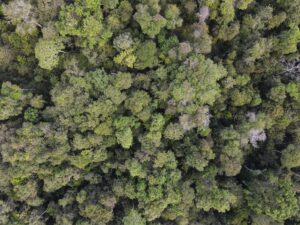Early warning signals of drought-induced tree mortality in Amazon forests
Background and Motivation. The Amazon’s forests are the most biodiverse on the planet, absorb 5-10% of global CO2 emissions1 and sustain rainfall over continental scales2. However, the invaluable ecosystem and climate services these forests provide are currently under severe threat from deforestation and changing climate. This threat is particularly severe in southern Amazonia (SA), where temperature increases and dry season rainfall reductions3 have been particularly pronounced and where physiological and atmospheric measurements suggest that forests are already experiencing significant water stress, enhancing mortality risk.

To better understand plant physiological thresholds that result in drought-induced tree mortality in this critical region, the project team is leading the installation of a new 1-ha drought experiment in the southern limits of the Amazon biome in the Brazilian state of Mato Grosso4. At this site, a large number of measurements will be made on forest canopy trees to evaluate plant water stress status (e.g. leaf water potential, embolism status) and its impacts on plant function (e.g. sap flow, growth, mortality). Changes in leaf spectral properties as plant water stress intensifies will also be measured.
Aims, Objectives & Methodological Approach. A key current challenge is the prediction of drought-induced mortality risk. This PhD will use data from the new southern Amazon drought experiment to evaluate early warning signatures of tree death under drought. These signatures may include changes in the temporal pattern of tree growth leading up to death5, changes in leaf carbohydrate status6 or pre-mortality changes in leaf spectra7. The student will also have access to historical data collected at a long-running (>20 years) drought experiment in northeastern Amazonia8, Amazon-wide datasets of tree growth and mortality in response to natural drought events9 and Amazon-wide plant functional traits databases10.
The PhD is open-ended but key questions may include: 1) Which individual-level attributes are most related to drought-induced mortality risk?, 2) How consistently do these attributes predict drought-mortality risk across drought experiments in different Amazon regions and in response to natural drought events?
The specific methodological approaches will depend somewhat on the interests of the student but could include 1) large-scale statistical analysis of pre-death growth patterns under drought, 2) remote-sensing based approaches to predict water stress from space using multispectral (Sentinel-2) and hyperspectral data (e.g. DESIS, Pixel) or/and 3) new targeted field measurements that complement the existing suite of measurements. Students with strong quantitative skills with a capacity to integrate a broad range of data streams are especially encouraged to apply.
Supervision. The supervisory team has a sustained track record in studying the impacts of climate change in Amazonia and is highly multidisciplinary in nature, with expertise including plant ecophysiology, forest ecology and remote sensing. The student will be based at the School of Geography, University of Leeds within the Ecology and Global Change cluster, a world-leading research group with a strong focus on tropical forests. The student will have opportunities to contribute to field data collection in the southern Amazon in collaboration with co-supervisors Beatriz and Ben Hur Marimon and to also to spend time in co-supervisor Adami’s research group in the Brazilian Space Institute (INPE) if the PhD develops in a remote sensing direction.
References. 1.Brienen et al. 2015, Nature 519:344-48. 2. Spracklen et al. 2012, Nature 489:282-285. 3. Haghtalab et al. 2020. Theoretical and Applied Climatology 140:411-427. 4. Lethal Psi: Characterising critical embolism thresholds for Amazon tree survival. http://gotw.nerc.ac.uk/list_full.asp?pcode=NE%2FX001164%2F1. 5. Cailleret et al. 2019, Frontiers in Plant Science: 1964. 6. Signori-Muller et al. 2021, Nature Communications 12:2310. 7. Doughty et al. 2020. Biotropica 53:581-595. 8. Rowland et al. 2015. Nature 528-119-122. 9. Bennett et al. 2023, Nature Climate Change 13:967-74. 10. Tavares et al. 2023. Nature 617:111-117.
